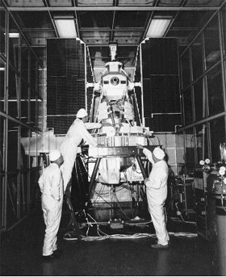October 30, 2009 Vol. 2, Issue 10
Nimbus 7, which launched on October 24, 1978, provided important heritage for Earth-observing environmental research satellites that followed in its path.
The Nimbus 7 observatory was the last of seven Nimbus global research satellites. It is best known for delivering data that stirred public awareness and prompted the first global efforts to protect the ozone layer after it spotted significant depletion in the Antarctic during the 1980s.
Nimbus 7’s mission focused on measurements of oceanographic and atmospheric features of the planet never measured before by the Nimbus observatories. It also called for broadening participation among the scientific community and making the returned data more accessible to users.

Nimbus 7
The observatory carried nine instruments, two of which were new: the Total Ozone Mapping Spectrometer (TOMS) and the Coastal Zone Color Scanner (CZCS). TOMS measured total ozone depletion and found significant amounts around the Antarctic region. It also measured the sizes of volcanic eruption, a feat previously left to rough estimates and best guesses. CZCS measured ocean “color” which correlated with a variety of ocean life. As a result, the commercial fishing industry could track schools of fish using satellite imaging.
Other instruments on board were the Solar Backscatter Ultraviolet (SBUV), which measured ozone levels in the stratosphere, contributing to the TOMS instrument findings, and the Scanning Multichannel Microwave Radiometer (SMMR). SMMR measured global phenomena such as snow cover, rainfall, soil moisture, and was the first to make more precise, all weather observations of global sea ice concentrations, their age, and sea surface temperatures.
Nimbus 7 orbited the Earth for seventeen years, retiring on February 14, 1995.
The purpose of the Nimbus program was to study the atmospheric environment, weather, oceanography, and other geophysical properties of Earth’s structure. The observatories contributed to a better understanding of the space environments impact on the craft and the development of increased space-hardened electrical components and improved lubrication techniques.
Other technical firsts for the observatories were the sun-tracking solar panel arrangement and the three-axis stabilization, Earth-pointing attitude control system, which maintained attitude within one degree and with low jitter. These observatories also operated past the initially expected lifecycle of six months, extending to six to fifteen years.
Significant traces of the Nimbus program live on through heritage designs. The Earth Observing System (EOS), designed to answer questions put forth by Nimbus, borrowed significant amounts of heritage from the observatories. Landsat satellites 1, 2, and 3 used Nimbus designs for temperature control, structure, attitude control, and telemetry. The Nimbus Program was so influential that the heritage of instruments on most global resource observing satellites launched over the past thirty years can be traced at least in part to Nimbus instrument technology and scientific accomplishments.
Read more about the history of the Nimbus Program (PDF).
See images of the Nimbus 7.





